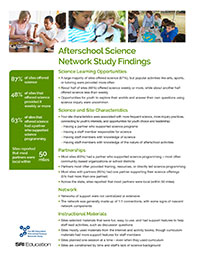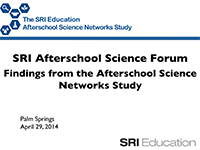Findings
Science Learning Opportunities
- A large majority of sites offered science (87%), but popular activities like arts, sports, or tutoring were provided more often
- About half of sites (48%) offered science weekly or more, while about another half offered science less than weekly
- Opportunities for youth to explore their worlds and answer their own questions using science inquiry were uncommon Science and Site Characteristics
- Four site characteristics were associated with more frequent science, more inquiry practices, connecting to youth’s interests, and opportunities for youth choice and leadership:
- Having a partner who supported science programs
- Having a staff member responsible for science
- Having staff members with knowledge of science
- Having staff members with knowledge of the nature of afterschool activities
Partnerships
- Most sites (63%) had a partner who supported science programming – most often community-based organizations or school districts
- Partners most often provided training, resources, or directly led science programming
- Most sites with partners (95%) had one partner supporting their science offerings (5% had more than one partner)
- Across the state, sites reported that most partners were local (within 50 miles)
Network
- Networks of support were not centralized or extensive
- The network was generally made up of 1:1 connections, with some signs of nascent network components
Instructional Materials
- Sites selected materials that were fun, easy to use, and had support features to help staff lead activities, such as discussion questions
- Sites mostly used materials from the Internet and activity books, though curriculum materials had more support features for staff members
- Sites planned one session at a time – even when they used curriculum
- Sites are constrained by time and staff’s lack of science background



